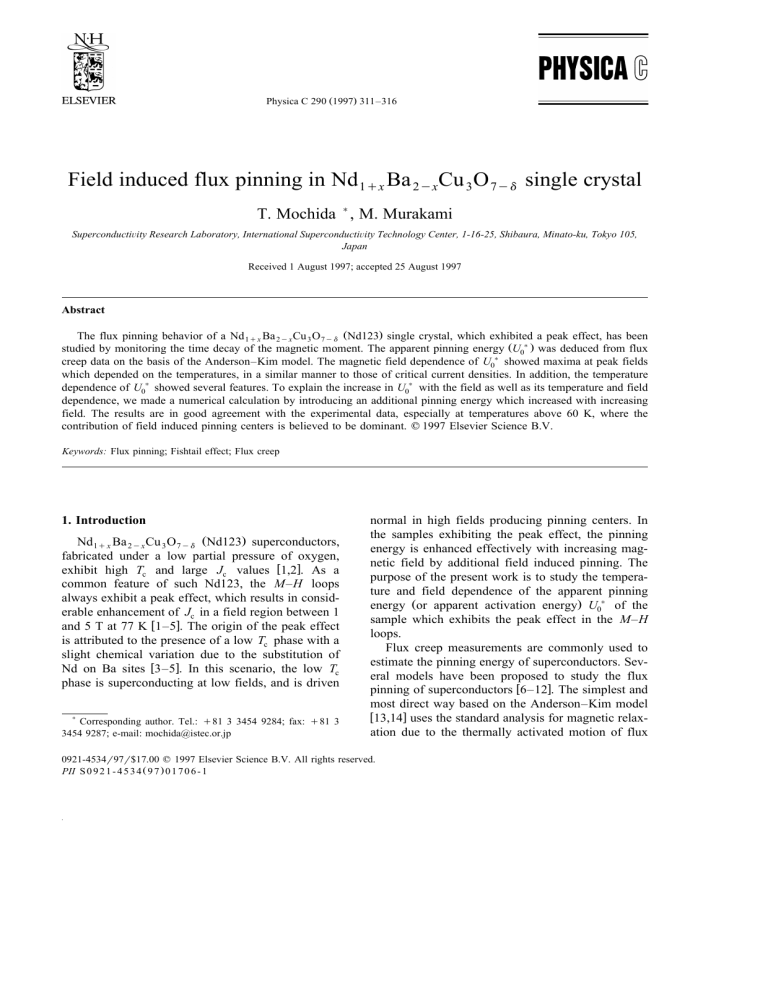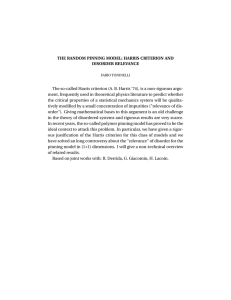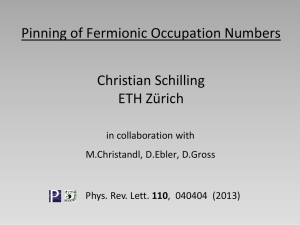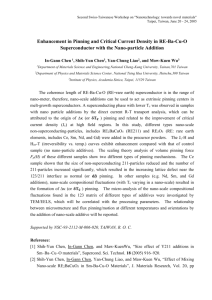Field induced flux pinning in Nd Ba Cu O single crystal
advertisement

Physica C 290 Ž1997. 311–316 Field induced flux pinning in Nd 1qx Ba 2yxCu 3 O 7yd single crystal T. Mochida ) , M. Murakami SuperconductiÕity Research Laboratory, International SuperconductiÕity Technology Center, 1-16-25, Shibaura, Minato-ku, Tokyo 105, Japan Received 1 August 1997; accepted 25 August 1997 Abstract The flux pinning behavior of a Nd 1qx Ba 2yx Cu 3 O 7y d ŽNd123. single crystal, which exhibited a peak effect, has been studied by monitoring the time decay of the magnetic moment. The apparent pinning energy ŽU0) . was deduced from flux creep data on the basis of the Anderson–Kim model. The magnetic field dependence of U0) showed maxima at peak fields which depended on the temperatures, in a similar manner to those of critical current densities. In addition, the temperature dependence of U0) showed several features. To explain the increase in U0) with the field as well as its temperature and field dependence, we made a numerical calculation by introducing an additional pinning energy which increased with increasing field. The results are in good agreement with the experimental data, especially at temperatures above 60 K, where the contribution of field induced pinning centers is believed to be dominant. q 1997 Elsevier Science B.V. Keywords: Flux pinning; Fishtail effect; Flux creep 1. Introduction Nd 1q x Ba 2yx Cu 3 O 7y d ŽNd123. superconductors, fabricated under a low partial pressure of oxygen, exhibit high Tc and large Jc values w1,2x. As a common feature of such Nd123, the M–H loops always exhibit a peak effect, which results in considerable enhancement of Jc in a field region between 1 and 5 T at 77 K w1–5x. The origin of the peak effect is attributed to the presence of a low Tc phase with a slight chemical variation due to the substitution of Nd on Ba sites w3–5x. In this scenario, the low Tc phase is superconducting at low fields, and is driven ) Corresponding author. Tel.: q81 3 3454 9284; fax: q81 3 3454 9287; e-mail: mochida@istec.or.jp normal in high fields producing pinning centers. In the samples exhibiting the peak effect, the pinning energy is enhanced effectively with increasing magnetic field by additional field induced pinning. The purpose of the present work is to study the temperature and field dependence of the apparent pinning energy Žor apparent activation energy. U0) of the sample which exhibits the peak effect in the M–H loops. Flux creep measurements are commonly used to estimate the pinning energy of superconductors. Several models have been proposed to study the flux pinning of superconductors w6–12x. The simplest and most direct way based on the Anderson–Kim model w13,14x uses the standard analysis for magnetic relaxation due to the thermally activated motion of flux 0921-4534r97r$17.00 q 1997 Elsevier Science B.V. All rights reserved. PII S 0 9 2 1 - 4 5 3 4 Ž 9 7 . 0 1 7 0 6 - 1 T. Mochida, M. Murakamir Physica C 290 (1997) 311–316 312 lines Žor flux creep. out of the potential wells aided by the Lorentz force. The simplest assumption of a linear J-dependent form for the U0) gives J ž / U0) s U0 y JBVa s U0 1 y Jc Ž 1. where U0 is pinning energy at J s 0, V is the volume of the flux bundle, a is the hopping distance and Jc s U0rBÕa is the critical current density at which the pinning energy disappears. Using the above linear approximation and solving the flux creep equation for the lowest order, one obtains the logarithmic decay for the irreversible magnetization, i.e. ½ MŽ t. s 1y kT U0) ln t ž /5 t0 Ž 2. where t 0 is the macroscopic attempting time for the flux motion, U0) is the apparent pinning potential and k is the Boltzmann constant. From the logarithmic form of the M Ž t . decay, one can deduce the normalized relaxation rate S to determine the U0) : U0) s y kT S . Ž 3. 3. Results and discussion Ž 4. The field dependence of the Jc for temperatures between 70 K and 86 K is shown in Fig. 1. The sample shows a Jc value of 35 000 Arcm2 at 77 K Here S is defined as S' dln M 1 dM s dlnt 1 dM f M dlnt Mi dlnt was decreased from 500 to 3008C over 400 h. The sample dimensions were 1.18 = 1.38 = 0.47 mm3 with the largest cross-section perpendicular to the c-axis. The sample showed a sharp superconducting transition with an onset Tc of 91.5 K. Magnetization loops were measured using a Quantum Design MPMS-7 SQUID magnetometer with a temperature and field range of 5 to 86 K and 0 to 7 T with the field applied parallel to the c-axis. The critical current densities, Jc , were calculated using the extended Bean model w18x. The magnetic relaxation rate was obtained by measuring the time decay of the magnetic moment for about 1 h as described by van Dalen et al. w19x. The first data point was taken after 200 s to avoid deviation from a pure logarithmic decay. During the relaxation measurements, the scan length was kept at 3 cm to avoid field inhomogeneities. In all cases, the field was swept to a sufficiently low negative value to ensure full flux penetration, before sweeping to the desired target value. where Mi is the initial magnetization. Although a minor error is introduced by using Mi instead of M, it is not critical as long as the variation in M during the experiment is small. The U0) obtained by this model corresponds to the U axis intercept of the straight line tangent to UŽ J . at the measured temperature and current w15,16x. Although the model is simplified, U0) values give valuable information about the pinning characteristics of a sample because these values are widely discussed for many high-Tc superconductors. 2. Experimental A single crystal of Nd 1q x Ba 2yx Cu 3 O 7y d was fabricated by a flux method in 1% O 2 , using details which are described elsewhere w17x. The crystal was annealed in flowing oxygen while the temperature Fig. 1. Field dependence of the critical current densities, Jc , obtained from magnetic hysteresis loops, measured at temperatures of 70, 74, 77, 80, 83 and 86 K. T. Mochida, M. Murakamir Physica C 290 (1997) 311–316 Fig. 2. Semi-logarithmic plots of the time dependence of the irreversible magnetization, measured at temperatures of 70, 77, 80, 83 and 86 K. The solid lines show linear regression fits based on the Anderson–Kim model. Note that no deviation from pure logarithmic behavior occurs. and 1.25 T, which is comparable to the values reported in other Nd123 crystals w1–5x. Clear secondary peak effects are also observed in Jc – m 0 Ha curves. The peak field Hp, J that gives the maximum Jc value becomes larger with decreasing temperature w3–5x. The typical time dependence of the magnetic moment is shown in Fig. 2. For all the temperatures, an almost linear dependence of the magnetic decay on the logarithmic time scale was found, showing that U is linearly dependent on J in the measured current region. Therefore, we deduced the normalized relaxation rate S, from the curve of the M vs. ln t. Thus the apparent pinning energy U0) , which we define here by U0) s ykTrS, can also be determined. The field dependence of U0) values is shown in Fig. 3. The U0) – m 0 Ha curves show a field dependence similar to Jc – m 0 Ha curves. The peak effect is also observed such that U0) values increase with field up to peak fields Hp,U , and then decrease with further increasing field. Like the Jc – m 0 Ha curves, the peaks become broader with the Hp,U shifting to higher fields and with decreasing temperature. The peaks in U0) – m 0 Ha curves are almost identical to 313 the peaks in Jc – m 0 Ha curves. These results suggest that the peak in U0) and Jc has the same origin. In most cases, U0) values monotonously decrease with increasing field w20–22x. This is understood by considering the fact that the pinning energy monotonously decreases with field. Therefore, the enhancement in U0) with field in a Nd123 single crystal is not commonly observed, and we believe that the secondary peak effect is responsible for such unusual behavior. In the Nd123 system, there are Nd rich clusters which are distributed in the matrix w3,23x. Such Nd rich clusters with depressed Tc are known to act as field induced pinning centers: they are superconducting in a low field and driven normal in higher fields, and thus can act as pinning centers w24x. The trigger field for pinning is dependent on temperature. The pinning potential thus increases with increasing field up to a characteristic field of H ) , where all the field induced pining centers become active. We assume that the order of magnitude of H ) is the same as Hp,U and Hp, J . Above H ) , where no effective activation of the field induced pinning centers takes place, the field dependence of U0) becomes normal and thus shows a monotonous decrease with field. This is the origin of the peaks in U0) – m 0 Ha curves. It should be born in mind that for effective pinning the clusters may not necessarily be in the normal state. There is a threshold criterion for pin- Fig. 3. The field dependence of apparent pinning energy U0) s yT rS at T s10, 30, 50, 60, 70, 77 and 83 K. 314 T. Mochida, M. Murakamir Physica C 290 (1997) 311–316 Fig. 4. The temperature dependence of apparent pinning energy U0) syT rS obtained through a numerical fitting of the experimental data to the Anderson–Kim model. Results for 0, 0.25, 0.5, 1, 2 and 7 T are plotted. ning such that the change in the order parameter Ž DC . should exceed some critical value depending on the size of pinning center Ž d .. This criterion can be written as U0rd where U0 is the depth of pinning energy. For low Tc materials it is known that the threshold value of U0rd is around 2r3 w25x. Therefore, even when the clusters are superconducting, they can act as pinning centers. The temperature dependence of the value of U0) for m 0 Ha s 0, 0.25, 0.5, 1, 2 and 7 T is shown in Fig. 4. When the external field is zero, U0) increases linearly with increasing temperature. An increase in U0) with an increase of temperature has been observed in various samples without the peak effect. Such samples include Y123 single crystals w26x, melt-processed Y123 with Y211 inclusions w20,21x, Pr-doped Y123 w27x and Y123 thin films w22x. The increase in U0) with temperature has been explained in terms of either a non-linearity of U–J relations w7,15x or a distribution of activation energies w6,26x. In the presence of a magnetic field, several features can be seen which reflect the unusual field dependence of U0) . First, the U0) values are higher than those in the remanent state for temperatures above the deviation temperatures ŽTd .. For example, the U0) value at 0.25 T is almost equal to the one in the remanent state at temperatures below 50 K. However, when the temperature is raised above 60 K, the U0) value at 0.25 T exceeds the value of the remanent state with the difference between the two values increasing with temperature. Second, the U0) –T curves show maximum values at peak temperatures Tp , above which the U0) values decrease with temperature. The peaks in U0) – m 0 Ha curves are identical to the peaks in U0) –T curves. It is also important to note that both the Td and Tp values shift to lower temperature with increasing field. This suggests that U0) values can be scaled by temperature and field. In order to account for the unusual increase in U0) , we assume a simple model based on the idea of field induced pinning. In this model, the pinning energy increases linearly with field up to the characteristic field of H ) . The H ) has, of course, a temperature dependent value which is described in the following discussion. Writing the pinning energy at T s T0 and H F H ) ŽT0 . as U0) Ž T0 , H . s U0) ,BG Ž T0 , H . q U0) ,FI Ž T0 , H ) Ž T0 . . H H) . Ž 5. where U0) ,BG ŽT0 , H . is the ‘background’ pinning energy and U0) ,FI ŽT0 , H ) ŽT0 .. is the contribution from the field induced pinning centers at T s T0 . The general form of U0) ,BG ŽT0 , H . would be w28,29x, ž U0) ,BK Ž T0 , H . s U0) ,BG Ž T0 . 1 y H Hc 2 Ž T0 . / Ž 6. where Hc2 ŽT0 . is the upper critical field at T s T0 . Since H r H c 2 Ž T 0 . < 1, then changes in U0) ,BG ŽT0 , H . as a function of H can be ignored. So U0) ,FI ŽT0 , H . is approximated as U0) ,BG Ž T0 , H . f U0) ,BG Ž T0 . . Ž 7. Then the field dependence of the pinning energy at T s T0 and H F H ) ŽT0 . becomes ½ U0) Ž T0 , H . s U0) ,BG Ž T0 . 1 q k H 5 ) H Ž T0 . Ž 8. where k is the ratio of U0) ,FI ŽT0 , H ) ŽT0 ..r U0) ,BG ŽT0 .. Assuming that the temperature dependence of U0) ,FI ŽT, H ) ŽT .. is identical to that of U0) ,BG ŽT ., Eq. Ž8. becomes ½ U0) Ž T , H . s U0) ,BG Ž T . 1 q k H ) H ŽT . 5 . Ž 8X . T. Mochida, M. Murakamir Physica C 290 (1997) 311–316 315 shown in Fig. 5. As no consideration has been given to the decrease in U0) above the peak, only the data below the Hp,U Žor below Tp in U0) –T curves. are plotted. The calculated values are in good agreement with the experimental results, especially in the temperature region above 60 K, where the contribution from field induced pinning centers is supposed to be dominant w4x. These results show that the increase in U0) below Hp,U is well described by introducing an additional pinning energy, which increases with magnetic field. 4. Conclusion Fig. 5. Results of experimental data Žpoints. and numerical calculation Žlines. of apparent pinning energy ŽU0) . at m 0 Ha s 0, 0.25, 0.5, 1 and 2 T. Experimental data obtained above the peak temperatures Tp are not plotted. For the numerical calculation, ms1.64, H0) s13.4 and k s 2.7. Since our results show that the peaks in U0) – m 0 Ha curves are almost identical to the peaks in Jc – m 0 Ha curves, it is reasonable to assume a same functional form between the H ) ŽT . and the Hp, J ŽT .. As the Hp, J ŽT . is written as Hp, J ŽT . s Hsc Ž1 y TrTx . m using a scaled field Hsc with parameters m ; 1.5 and Tx s Tc w30x, the H ) ŽT . is T Ž 9. Tc with a characteristic magnetic field H0) and a fitting parameter m. Finally, the temperature and field dependence of the U0) at T and H - H ) ŽT . becomes U0) Ž T , H . s U0) ,BG Ž T . = 1qk H H0) Acknowledgements m ½ ž /5 H ) Ž T . s H0) 1 y We have measured the magnetic relaxation of a Nd 1q x Ba 2yx Cu 3 O 7y d single crystal with a peak effect. The relaxation process is found to be well described by the Anderson–Kim model in the time window of our experiment. The apparent pinning energy ŽU0) . showed unusual temperature and field dependence in that an increase in U0) is observed. Such an increase in U0) can be explained by assuming an additional pinning energy, which increases with magnetic field. 1 y Ž TrTc . 4 m . Ž 10 . Fitting the experimental data to Eq. Ž9., we obtained H0) s 13.4 and m s 1.64, which are in the same order of magnitude as in the literature w30x. For the U0) ,BG ŽT . values, we adopted the experimentally obtained U0) values in the remanent state. Using these values, we found k s 2.7, which gave good agreement with the experimental data. The experimental Žpoints. and theoretical Žlines. temperature dependence of U0) at different applied field are This work was partially supported by NEDO. The authors thank Mr. K. Sawada for preparing the sample. We thank both Dr. M.R. Koblishka and Dr. A.J.J. van Dalen for useful advice concerning SQUID measurements. We are grateful to Dr. N. Chikumoto, Dr. M. Wahahiki, Mr. T. Higuchi and Dr. A. Anderson for helpful suggestions. Acknowledgment is also due to Dr. S.I. Yoo and Mr. N. Sakai for continuous encouragement. References w1x M. Murakami, S.I. Yoo, T. Higuchi, N. Sakai, J. Appl. Phys. 33 Ž1994. L715. w2x S.I. Yoo, N. Sakai, H. Takaichi, T. Higuchi, M. Murakami, Appl. Phys. Lett. 65 Ž1994. 633. w3x T. Egi, J.G. Wen, K. Kuroda, H. Unoki, N. Koshizuka, Appl. Phys. Lett. 67 Ž1995. 2406. w4x T. Egi, J.G. Wen, K. Kuroda, H. Mori, H. Unoki, N. Koshizuka, Physica C 270 Ž1996. 223. 316 T. Mochida, M. Murakamir Physica C 290 (1997) 311–316 w5x T. Higuchi, S.I. Yoo, K. Sawada, N. Sakai, M. Murakami, Physica C 263 Ž1996. 396. w6x C.W. Hagen, R. Griessen, Phys. Rev. Lett. 62 Ž1989. 2857. w7x M.P. Maley, J.O. Willis, H. Lessure, M.E. McHenry, Phys. Rev. B 42 Ž1990. 2639. w8x P.J. Kung, M.P. Maley, M.E. McHenry, J.O. Willis, M. Murakami, S. Tanaka, Phys. Rev. B 48 Ž1993. 13992. w9x M.P.A. Fisher, Phys. Rev. Lett. 62 Ž1989. 1415. w10x M.V. Feigel’man, V.B. Geshkenbein, A.I. Larkin, M. Vinokur, Phys. Rev. Lett. 63 Ž1989. 2303. w11x H.G. Schnack, R. Griessen, J.G. Lensink, W. Hai-Hu, Phys. Rev. B 48 Ž1993. 13178. w12x Y. Abulafia, A. Shaulov, Y. Wolfus, R. Prozorov, L. Burlachokov, Y. Yeshurun, D. Majer, E. Zeldov, V.M. Vinokur, Phys. Rev. Lett. 75 Ž1995. 2404. w13x P.W. Anderson, Phys. Rev. Lett. 9 Ž1962. 309. w14x P.W. Anderson, Y.B. Kim, Rev. Mod. Phys. 36 Ž1964. 39. w15x M.R. Beasley, R. Labusch, W.W. Webb, Phys. Rev. 181 Ž1969. 682. w16x Y. Yeshrun, A.P. Malozemoff, A. Shaulov, J. Rev. Mod. Phys. 68 Ž1996. 911. w17x K. Sawada, S.I. Yoo, N. Sakai, T. Higuchi, M. Murakami, Proceedings 4th Euro Ceramics 6, Gruppo Editoriale Faenza Editrice, Faenza, 1995, pp. 293. w18x H.P. Weisinger, F.M. sauerzopf, H.W. Weber, Physica C 203 Ž1992. 121. w19x A.J.J. van Dalen, M.R. Koblischka, H. Kojo, K. Sawada, T. Higuchi, M. Murakami, Superconduct. Sci. Technol. 9 Ž1996. 659. w20x M. Murakami, N. Nakamura, N. Koshizuka, S. Tanaka, P.J. Kung, M.P. Maley, J.O. Willis, Trans. Mat. Res. Soc. Jpn. 19A Ž1994. 425. w21x S. Takebayashi, M. Tanaka, M. Hashimoto, S. Uji, H. Aoki, Adv. Supercond. Ž1993. 467. w22x H.H. Wen, H.G. Schnack, R. Griessen, B. Dann, J. Rector, Physica C 241 Ž1995. 353. w23x W. Ting, T. Egi, K. Kuroda, N. Koshizuka, S. Tanaka, Appl. Phys. Lett. 70 Ž1997. 770. w24x M. Murakami, N. Sakai, T. Higuchi, S.I. Yoo, Superconduct. Sci. Technol. 9 Ž1996. 1015. w25x A.M. Campbell, J.E. Evetts, Adv. Phys. 21 Ž1972. 199. w26x H. Theuss, T. Reininger, H. Kronmuller, J. Appl. Phys. 72 Ž1992. 1936. w27x Y.G. Xiao, B. Yin, J.W. Li, Z.X. Zhao, H.T. Ren, L. Xiao, X.K. Fu, J.A. Xia, Superconduct. Sci. Technol. 7 Ž1994. 623. w28x G. Blatter, M.V. Feigel’man, V.B. Geshkenbein, A.I. Larkin, V.M. Vinokur, J. Rev. Mod. Phys. 66 Ž1994. 1125. w29x M. Tachiki, S. Takahashi, Solid State Commun. 70 Ž1989. 291. w30x M.R. Koblischka, A.J.J. van Dalen, T. Higuchi, K. Sawada, S.I. Yoo, M. Murakami, Phys. Rev. B 54 Ž1996. R6893.




